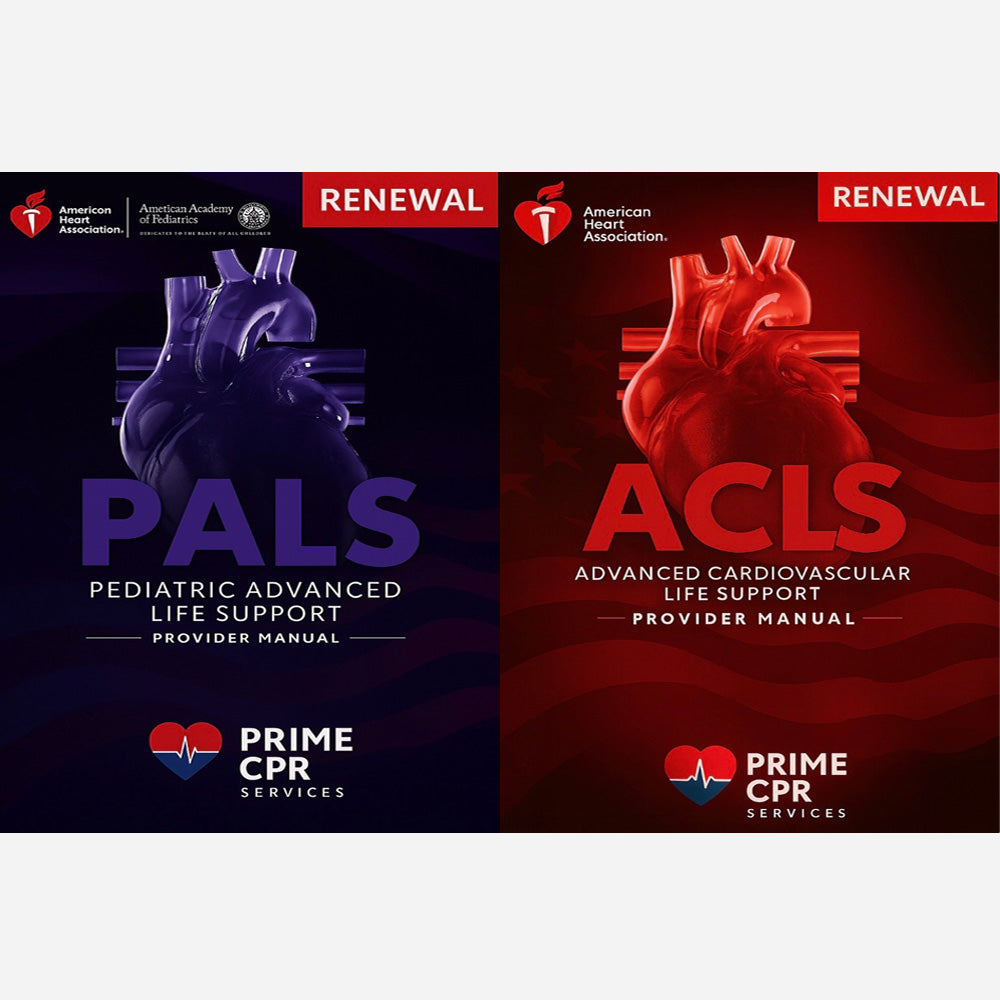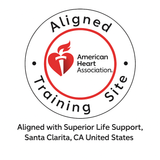PALS Renewal with ACLS Renewal: Essential Training for Healthcare Providers
Prime CPR Services offer this combo class of ACLS RENEWAL and PALS RENEWAL to make re-certification a breeze. Get the convenience of comprehensive review, comprehensive training materials, and experienced medical professionals in one easy class. Refresh your skills and renew your credentials with this relaxed, stress free course.


Books are shipped priority, so you will get them in plenty of time before your class. You could also purchase the PALS ebook by clicking HERE and the ACLS ebook by clicking HERE
The PALS RENEWAL course is stress free and relaxed. It is updated with the latest guidelines from the American Heart Association. We will explain everything in a way that is easy to understand and remember. It is designed for pediatricians, emergency physicians, family physicians, physician assistants, nurses, nurse practitioners, paramedics, respiratory therapists, and other healthcare providers who initiate and direct advanced life support in pediatric emergencies. You will receive your AHA PALS card right after the course. All cards are valid for 2 years.
PALS RENEWAL course teaches:
- Pediatric Assessment: Systematically assess pediatric patients, identify potential life-threatening conditions, and prioritize interventions based on the child's condition. This class goes over how to recognize infants and children at risk for cardiopulmonary arrest
- Basic Life Support (BLS) Skills: The course covers high-quality CPR (Cardiopulmonary Resuscitation) for infants, children, and adults, including chest compressions, rescue breaths, and the use of an Automated External Defibrillator (AED).
- Pediatric Algorithms: Participants are taught PALS-specific algorithms and flowcharts for managing various pediatric emergencies, such as respiratory distress, respiratory failure, bradycardia, tachycardia, and cardiac arrest.
- Respiratory Emergencies: The class covers the recognition and management of respiratory distress, respiratory failure, and respiratory arrest in pediatric patients.
- Cardiac Arrest Management: Participants learn the steps to manage cardiac arrest in infants and children, including the use of appropriate medications, defibrillation, and advanced airway management.
- Vascular Access: Techniques for obtaining vascular access in pediatric patients are taught, including intraosseous (IO) access and peripheral intravenous (IV) access.
- Pharmacology: The course covers the indications, dosages, and administration of medications used during pediatric resuscitation, such as epinephrine, amiodarone, and atropine.
- Bradycardia and Tachycardia Management: Participants learn to identify and manage various heart rhythms associated with bradycardia and tachycardia in pediatric patients.
- Post-Cardiac Arrest Care: The class covers critical care following successful resuscitation, including post-cardiac arrest interventions and targeted temperature management.
- Team Dynamics: Effective communication and teamwork during pediatric emergencies are emphasized to ensure efficient and coordinated care.
The ACLS RENEWAL course is stress-free and relaxed. It is updated with the latest guidelines from the American Heart Association Guidelines for Cardiopulmonary Resuscitation and Emergency Cardiovascular Care. It is designed primarily for healthcare professionals in emergency departments, intensive care units, critical care departments, surgical areas, or pre-hospital environments, such as physicians, nurses, paramedics, respiratory therapists, and other professionals who may respond to a cardiovascular emergency. You will get your ACLS card right after the class which is valid for 2 years. We will explain everything in a way to easily understand and remember.
ACLS RENEWAL covers the core principles, including:
- BLS Review: Basic Life Support (BLS). 1 and 2 Rescuer High-quality CPR for adults, children, and infants, use of a Bag Valve Mask (BVM), use of an Automated External Defibrillator (AED), and relief of choking.
- Systematic Approach: Assessment, Identification of rhythms, and appropriate interventions. Effective team dynamics, Roles and Responsibilities during a resuscitation, Management of a patient in cardiac arrest or other cardiovascular emergencies.
- Rhythm Recognition and Scenarios: Ventricular Fibrillation (VF) and Pulseless Ventricular Tachycardia (VT), as well as non-shockable rhythms like Asystole and Pulseless Electrical Activity (PEA). Sinus Bradycardia and Supraventricular Tachycardia (SVT)
- Electrical Therapy: Defibrillation, Cardioversion, and Pacing.
- Pharmacology: Indications, Dosages, and Administration routes of Atropine, Amiodarone, Adenosine, Epinephrine, and Dopamine.
- Post-Cardiac Arrest Care: Critical care following Return of Spontaneous Circulation (ROSC), including targeted temperature management and other post-cardiac arrest interventions.
Feel free to call, text or email us if you have any questions or concerns.
Understanding PALS Renewal
PALS (Pediatric Advanced Life Support) renewal is a vital course designed for healthcare providers who care for infants and children. The course updates your skills and knowledge related to pediatric emergencies. During this training, participants learn how to effectively recognize and manage respiratory and cardiac emergencies in young patients. The importance of staying current with PALS certification cannot be understated because it equips healthcare professionals with essential guidelines and techniques to save lives.
Integrating ACLS into Your Training
ACLS (Advanced Cardiovascular Life Support) renewal complements PALS renewal by providing advanced training in adult resuscitation. During the training, providers learn critical interventions, including the use of EKGs and medications to manage cardiac emergencies. This integration is crucial because emergencies can involve both pediatric and adult patients, so being proficient in both PALS and ACLS ensures you are prepared for any situation. This enhanced training optimizes patient outcomes and promotes confidence in emergency response.
The Benefits of Completing Both Courses
By completing both PALS and ACLS renewals, healthcare providers can enhance their professional credentials while ensuring they are equipped with the most effective and recent practices. This dual renewal not only keeps your certification active but also deepens your understanding of emergency protocols. Furthermore, it prepares you for real-life scenarios, ensuring that you’re ready for any emergency that may arise. This comprehensive approach increases your value as a healthcare provider and ultimately improves patient care.



